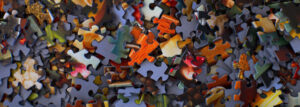Jigsaw Geography Presentation
At a Glance
Discipline
- Environmental science
Instructional Level
- University
Course
- Geography
Tasks in Workflow
Social Plane(s)
- Group
Type of Tasks
- Collecting & seeking information
- Creating & designing
- Presenting
- Taking a quiz & test
Technical Details
Useful Technologies
- Microsoft PowerPoint
Time
- Part of a semester (4-6 weeks)
Instructional Purpose
- Application & knowledge building
Overview
The aim of this approach is for student groups to teach the class 5 core concepts of 1 topic in the Fluvial Processes course over the semester until all of the 7 topics for the course have been covered. The 7 topics include: River channels, aquatic habitats, human impacts, river mechanics, erosion, sediment transport, and bedforms.
In the first 2 weeks of the semester, students form groups of 3-4 and research so that they are proficient in 1 of the 7 topics of the Fluvial Processes course and 5 core concepts within their topic area (defined by the instructor). Students can use reading materials provided by the instructor.
Students construct a 45 min presentation of their choice (for example: a video, an oral presentation, or a field trip) to deliver an overview of their topic and teach 5 core concepts within their topic area.
The students can use the instructor office hours to discuss what and how will they will teach the class. The students develop a 5 question quiz.Each group submits their presentation materials (for example: a PowerPoint) and their quiz to the course website by 5 PM the day prior to their presentation.
During class:
- A group presents their topic (1 per class). (In following class their quiz will be taken by the class).
- A final mark is given to the group following their presentation based on: creativity, proficiency, engagement (presentation skills).
- After the presentation, the instructor will clarify any misconceptions presented during the presentation and from the presentation material submitted 24 hours before the class.
- The instructor may have prepared PowerPoint slides before the class based on the material submitted.
- After the instructor’s lesson, the class takes the quiz from the group who presented in the previous class.
The presentations will occur over the entire semester until all of the seven topics of the course have been covered.
This approach was performed with a class of approximately 30 students.
Instructional Objectives
Students will be able to:
- To analyze a particular topic in the fluvial process course.
- To effectively communicate and engage in higher-level conversations of the topic area.
- To Practice presentation and communication skills in science and philosophy.
Workflow & Materials

Activity Workflow
Applied Strategies
Published: 18/09/2018
Copyright: © 2024 Miller. This is an open-access article distributed under the terms of the Creative Commons Attribution License (CC BY). The use, distribution or reproduction in other forums is permitted, provided the original author(s) and the copyright owner(s) are credited and that the original publication on this website is cited, in accordance with accepted academic practice. No use, distribution or reproduction is permitted which does not comply with these terms.



